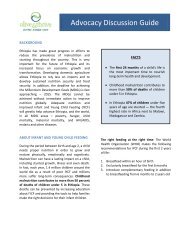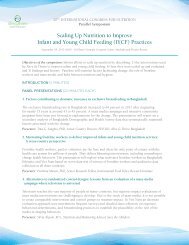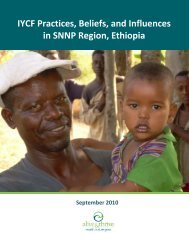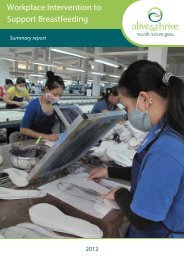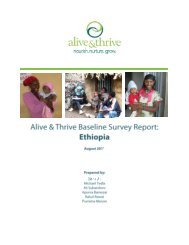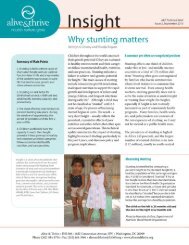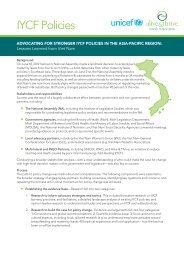Dads can do that! - Alive & Thrive
Dads can do that! - Alive & Thrive
Dads can do that! - Alive & Thrive
You also want an ePaper? Increase the reach of your titles
YUMPU automatically turns print PDFs into web optimized ePapers that Google loves.
Spotlight on Innovation<strong>Dads</strong> <strong>can</strong> <strong>do</strong> <strong>that</strong>!Deciding to focus on fathersAs you consider whether to invest inengaging fathers for better childfeeding, 3 criteria will be helpful:Criterion 1. Do fathers in your community/culture play astrong role in the decisions on how the baby is fed?Criterion 2. Would fathers be willing and able to takesome simple actions in support of breastfeeding and/orimproved complementary feeding practices?Criterion 3. Are fathers easily reached through the channelsyou would use?Your formative research should engage both fathersand key stakeholders who have insights into the localculture. To answer Criterion 1, explore:• What feeding practices need to change to have thegreatest impact on children’s nutrition during thefirst 2 years of life?• What are fathers’ current roles in child feeding?• Do fathers recognize the impact <strong>that</strong> their wordsand actions have on how their children are fed?• What value <strong>do</strong> fathers place on nutrition?• What facts about child feeding <strong>do</strong> fathers alreadyknow?• What gender-based constraints hinder fathers’involvement?• What are the gender-based opportunities for involvingfathers in child feeding? Explore fathers’ accessto assets and their power and decision making.To determine fathers’ willingness to act (Criterion 2), test outclear, simple actions <strong>that</strong> fathers might take in support ofimproved feeding practices. For example, ask fatherswhether they would be willing to speak to the baby’sgrandmothers in support of exclusive breastfeeding for 6months. Or ask fathers how likely they would be to keep anegg to feed to the baby instead of selling all the eggs at themarket.And to weigh Criterion 3, on channels to reach fathers,ask about fathers’ attendance at certain community orentertainment events, use of specific mass media channels,and participation at the health center.With data, you <strong>can</strong> determine whether a focus on fatherswill enhance your behavior change campaign and leadto improved infant and young child feeding practices.2 *Available at aliveandthrive.org/fathersbriefIssue 1 October 2012
Spotlight on Innovation<strong>Dads</strong> <strong>can</strong> <strong>do</strong> <strong>that</strong>!How we did it: Using data and simple criteriato decide to focus on fathers<strong>Alive</strong> & <strong>Thrive</strong>’s staff in Ethiopia considered whetherto devote resources to reaching out to fathers. Fromin-depth interviews and household observations, welearned <strong>that</strong> a baby’s grandmothers and father all playa role in determining how the child is fed. Fathers weremost commonly viewed as influencing child feedingpractices only indirectly, primarily in their roles as providerand as the one who controls family finances.We included focus groups with men in our formativeresearch. We learned <strong>that</strong> while fathers generally <strong>do</strong> notconsider themselves to play a direct role in child feeding,they expressed interest in learning more. Mothers andhealth workers told us <strong>that</strong> men’s words and actions <strong>do</strong>influence mothers’ decisions about feeding. Criterion 1was met: Fathers play an important role and are interestedin becoming more explicitly involved.A rapid assessment our Ethiopia staff conducted withfathers indicated <strong>that</strong> there were a number of possibleactions they would be willing to take in support of improvedfeeding practices – Criterion 2.As for Criterion 3, channels to reach fathers, we had datashowing <strong>that</strong> in Ethiopia, men have much more access toboth radio and TV than women <strong>do</strong>. We decided to focusthe mass media component of our program on fathers.Men are also involved through activities with religiousleaders and through the community outreach component,called Smart & Strong Family.Literature Review*The accompanying literature review provides aperspective on studies others have conductedand on child feeding interventions <strong>that</strong> havebeen tested with fathers.<strong>Alive</strong> & <strong>Thrive</strong> tested concepts for a TV spot <strong>that</strong>would appeal to fathers’ emotions. For moreon <strong>that</strong> concept test, visit aliveandthrive.org/research-to-action.6 strategies <strong>that</strong> work<strong>Alive</strong> & <strong>Thrive</strong> is learning about how to involve fathers inchild feeding. Our experience has led us to 6 strategieswe believe will help ensure effective interventions. Considerthese strategies as you develop your own fathers’programs.Strategy 1: Grab them with emotion.First we feel. Then we think.A&T has successfully used emotions – especially positiveemotions – to draw fathers in. Positive feelings <strong>can</strong> influencesocial behavior. Studies confirm <strong>that</strong> when theyreceive messages <strong>that</strong> evoke positive feelings, people:• Are more receptive to the message• Recall the message better• Are more likely to comply with the message 1An infectious music video* in Ethiopia draws in listenersthrough beautiful visuals, smiling children, and a positive,<strong>can</strong>-<strong>do</strong> feel. It opens with a line <strong>that</strong> evokes ‘emotion: “Who <strong>do</strong>es not want to enjoy his harvest andkiss his child?” It continues:Issue 1 October 2012*Available at aliveandthrive.org/fathersbrief3
Spotlight on Innovation<strong>Dads</strong> <strong>can</strong> <strong>do</strong> <strong>that</strong>!Let’s not distinguish between father and motherLet’s feed him so we <strong>can</strong> celebrate the hopeA child’s health is the country’s healthLet him grow to be a light for generationsA small intervention study in Viet Nam, supportedthrough <strong>Alive</strong> & <strong>Thrive</strong>, showed <strong>that</strong> fathers will speak upfor improved breastfeeding practices. A photo of a lovingyoung couple and their breastfeeding baby, feature<strong>do</strong>n a poster and a brochure*, draws men in to focus onthe campaign’s messages.How we did it: Testing concepts to find compellingand emotion-based approachesBased on data, A&T had determined <strong>that</strong> its Bangladeshmass media campaign should feature fathers – as wellas grandmothers and <strong>do</strong>ctors. In fact, one of the 6 TVspots would address fathers directly. The creative teamdeveloped 3 possible concepts for <strong>that</strong> spot to test withthe target audience.To the surprise of staff, an emotion-packed storyline witha child saving his father from a house fire was more compellingthan a spot featuring a renowned cricket player.In another spot, the father of a newborn supports hiswife when she insists on offering their baby the breastwithin the first hour after birth. His observation, “I’mlucky the mother of my baby is so intelligent,” is an emotionaldraw for viewers. Visuals, sound effects, and musicall add to the emotion and drama.Strategy 2. Ease the way by bustingstereotypesIn most cultures, feeding children is seen as women’sconcern, even though fathers ultimately control thepurse strings. Fathers are often unconscious of the rolethey play, yet what they <strong>do</strong> and say is exerting an influenceon household decisions about feeding.<strong>Alive</strong> & <strong>Thrive</strong>’s national program in Viet Nam makescounseling on IYCF widely available through a franchisemodel. Fathers are welcome in the IYCF counseling sessionstoo. Several of the illustrated counseling cards*(job aids to ensure <strong>that</strong> counselors cover critical points)portray fathers taking an active role in child feeding. Fathers’presence in these illustrations works subtly to helpshift social norms, making it seem natural for men to beinvolved in child feeding.Gender roles are deeply embedded in culture, but sometimesit takes just a little humor or a surprising fact tohelp fathers take an active role in child feeding.<strong>Alive</strong> & <strong>Thrive</strong>’s nationalprogram in Viet Nam producedcounseling cardswith images of fatherssupporting their wivesin feeding their children.These illustrations (aspictured on right) worksubtly to help shift socialnorms, making it seemnatural for men to be involvedin feeding matters.4 *Available at aliveandthrive.org/fathersbriefIssue 1 October 2012
Spotlight on Innovation<strong>Dads</strong> <strong>can</strong> <strong>do</strong> <strong>that</strong>!How we did it: Making it “manly” to leadthe family to support 6 months of exclusivebreastfeedingIn the Viet Nam breastfeeding study, humor helps openthe <strong>do</strong>or. A cartoon image of a breast on a ceramic muggets dads laughing and coming back to the clinic torequest more mugs. In a society where fathers traditionallyleave decisions about breastfeeding to the baby’smother and grandmothers, the fathers who participatein this program quickly begin speaking up for exclusivebreastfeeding. It helps <strong>that</strong> they <strong>can</strong> join with otherdads. An imaginative contest with the feel of a reality TVshow helps make it seem manly to support breastfeeding.Teams of fathers compete to show “Who loves theirwife and children most?” by demonstrating what theyknow about the value of breastfeeding and making themost convincing pro-breastfeeding argument.A cartoon image of a breast on aceramic mug gets dads laughingand coming back to the clinic torequest more mugs.Strategy 3. Find fathers where theyalready areEvery community has its gathering spots for men. Successfulfathers’ programs meet men where they are. Andin addition to where fathers “physically” are, we <strong>can</strong> meetthem where they are in terms of their knowledge andbeliefs.How we did it: Investing in channels <strong>that</strong>already reach fathersBangladesh’s first-ever chance to host games for theCricket World Cup coincided with A&T’s campaignlaunch. What better place to reach men – one of ourmain target audiences – than in the tea rooms andhomes where they would gather to celebrate the nationalsport? It was costly, but A&T purchased air timeduring the games, and reached men nationwide.In both Bangladesh and Ethiopia, A&T engages male religiousleaders to spread specific messages about infantand young child feeding, especially among fathers.In the Viet Nam intervention study, project staff adjusttheir schedules so they <strong>can</strong> find men at home for face-TV spots in Ethiopia* appeal tomale farmers by using agrarianthemes and analogies, meetingmen where they “are.”Issue 1 October 2012*Available at aliveandthrive.org/fathersbrief 5
Spotlight on Innovation<strong>Dads</strong> <strong>can</strong> <strong>do</strong> <strong>that</strong>!to-face counseling visits. They schedule group counselingfor fathers at the clinic on monthly immunizationdays, when fathers are already accompanying their wivesand babies to the clinic.Meeting fathers where they “are” in terms of their knowledgeand beliefs is just good behavior change practice.The Ethiopia mass media campaign is built upon analogiesrelated to farming. A TV spot to promote a varieddiet links the value of giving baby a variety of nutritionalfoods with the farmer’s value of rotating crops for a betterharvest.Strategy 4. “Provide crystal-clear direction”for actions fathers <strong>can</strong> takeFor real changes in behavior, program planners need tobe explicit about what the audience members <strong>can</strong> <strong>do</strong>to make a difference. We may teach a father the valueof a specific improved feeding practice, but <strong>that</strong> knowledgegoes nowhere unless he knows what he <strong>can</strong> <strong>do</strong>to support the practice. We borrow the phrase “providecrystal-clear direction” from the authors of Switch: How tochange things when change is hard. The authors recommend“scripting the critical moves and thinking in termsof specific behaviors.” As they say, “Change is easier whenyou know where you’re going and why it’s worth it.” 2Leaders in behavior change have shown the value ofnaming “small, <strong>do</strong>able actions” – things people <strong>can</strong> easily<strong>do</strong> <strong>that</strong> will lead to better health. For fathers, <strong>that</strong> maymean actions they <strong>can</strong> take <strong>that</strong> support improved feedingpractices – even if someone else is <strong>do</strong>ing the feeding.To be on <strong>that</strong> list of small, <strong>do</strong>able actions the programshould promote among fathers, the action must:• Clearly support the priority feeding practice• Be something fathers are willing and able to <strong>do</strong>.How we did it: Naming clear and simple actionsfathers <strong>can</strong> takeOne of the strengths of the Viet Nam study is its crystalcleardirection for dads. A specific and detailed listencourages fathers to take steps <strong>that</strong> support breastfeeding.This sample list* may be a good starting pointas you begin to name actions <strong>that</strong> fathers in your setting<strong>can</strong> <strong>do</strong>.<strong>Alive</strong> & <strong>Thrive</strong>’s grantee in Viet Nam, atHanoi School of Public Health, produceda brochure with a set of clear actions forfathers to take, such as, “going to themarket; cooking; <strong>do</strong>ing laundry; lookingafter the older children…” *This “menu” of actions is central to the Vietnamese campaign,appearing in the colorful brochure and on a largeposter displayed at the clinic. The actions are also promotedin counseling sessions and during the men’s contest.The list <strong>do</strong>esn’t stop at suggesting <strong>that</strong> dads “help withhouse chores.” It goes on to offer specific steps, “such6 *Available at aliveandthrive.org/fathersbriefIssue 1 October 2012
Spotlight on Innovation<strong>Dads</strong> <strong>can</strong> <strong>do</strong> <strong>that</strong>!as, going to the market; cooking; <strong>do</strong>ing laundry; lookingafter the older children…” and a reason why: “…so yourwife <strong>can</strong> maintain milk production and have enoughenergy to focus on taking care of your baby.”How did staff on the Viet Nam fathers’ project developthis list of actions? They report on the criteria they used:the actions for fathers should be “simple, <strong>do</strong>able, andeffective.” They drew upon several sources:• Information from the literature, including a study onfathers’ involvement and child development they hadpreviously conducted in the same area of the country• Data from their project’s baseline study, carried outbefore the intervention was implemented• The research team’s practical experience and knowledgeabout breastfeeding and local cultureThe A&T Ethiopia campaign also promotes actionsfathers <strong>can</strong> take to support complementary feeding.A critical feeding practice to prevent child stunting isadding animal source foods, like milk, eggs, and meat, tobaby’s diet, beginning at 6 months of age.Formative research in Ethiopia helped us see <strong>that</strong> evenin poor households, a few chickens may roam the yard.Families told us they could easily be convinced to keepan egg to add to baby’s porridge rather than sell all atthe market. A TV spot encourages fathers to keep an eggfor the baby. Other actions promoted include specificways to supervise their children’s feeding:• Make sure special foods like milk, powdered meat,and eggs, are added to child’s porridge• Make sure baby is given a variety of foods• Make sure baby eats thick porridge and not thingruelStrategy 5. Give fathers practiceEven though you’ve selected actions <strong>that</strong> are “small” and“<strong>do</strong>able,” the actions you are asking fathers to take arestill likely to be new, strange, and possibly uncomfortablefor them – at least until they have some practice.In the Viet Nam study, videoscenarios give fathers practice inspeaking up for breastfeeding. Inone scenario, a young mother buysinfant formula as she prepares toreturn to work. Fathers must comeup with a response to supportexclusive breastfeeding.How we did it: Designing materials <strong>that</strong>make fathers interact and <strong>that</strong> “model” thenew actionsActivities and materials <strong>that</strong> are designed to be truly interactive<strong>can</strong> give fathers the chance to practice speakingup for improved child feeding practices. In the Viet Namcontest to promote breastfeeding, teams of fathers competeto see who <strong>can</strong> come up with the most supportiveresponse to a scenario presented in a short video.*In one scenario, a young husband comes home to findhis wife wistfully trying to find a dress <strong>that</strong> will still fit her.She proposes <strong>that</strong> she will cut back on breastfeeding soshe <strong>can</strong> fit into her clothes. What is a husband to say?That’s the challenge fathers face in the contest – andtheir attempts to formulate a response <strong>that</strong> will supportboth the wife and breastfeeding <strong>can</strong> help them, andthe other contestants watching, to be ready for a similarchallenge at home.Even “passive” communication materials, like TV or radiospots, <strong>can</strong> give fathers “vicarious” practice by modelingthe actions we want them to take. Seeing how a father ina TV spot handles a situation could make it easier for theIssue 1 October 2012*Available at aliveandthrive.org/fathersbrief 7
Spotlight on Innovation<strong>Dads</strong> <strong>can</strong> <strong>do</strong> <strong>that</strong>!Access materials from brief:aliveandthrive.org/fathersbriefView full case study:aliveandthrive.org/fathersReferences{ }<strong>Alive</strong> & <strong>Thrive</strong>studyCase1Monahan, Jennifer L. “Thinkingpositively: Using positive affectwhen designing health messages.” InMaibach, Edward, Roxanne LouiselleParrott, editors. Designing healthmessages: Approaches from communicationtheory and public healthpractice. Thousand Oaks, Calif.: SagePublications, 1995. 81-98.2Heath, Chip, and Dan Heath. Switch:How to Change Things WhenChange Is Hard. New York: Broadway,2010.viewer to imagine himself <strong>do</strong>ing the same thing. In one of our Bangladeshspots*, the father responds to the <strong>do</strong>ctor’s advice by saying, “Now I understand.I <strong>can</strong> help with chores to give my wife time to feed our baby.” In othercampaign spots*, the father <strong>do</strong>esn’t say a word, but is seen actively playingwith his baby or cheering his child on during feeding time. (View the Bangladeshspots on “Animal Foods” and “Poor Appetite.”) The silent message isclear: A father needs to be involved in the family’s concerns about feeding.Strategy 6. Show fathers a benefit <strong>that</strong> they care aboutAll good behavior change interventions promote the benefits <strong>that</strong> peoplecare about, things <strong>that</strong> are meaningful to them personally. Sometimes thesebenefits go beyond the health benefits of the behavior.How we did it: Finding the “sweet spot,” <strong>that</strong> benefit <strong>that</strong>makes the change seem irresistibleAn outcome <strong>that</strong>’s easy to promote for many recommended feeding practicesis “intelligence.” All parents care about raising a smart child, and our formativeresearch in Ethiopia confirmed <strong>that</strong> the child’s education and intelligenceare a top priority for most fathers. A&T’s community outreach activities in<strong>that</strong> country are promoted as “Smart & Strong Families.” Fathers and mothershave a chance to earn a “Smart & Strong” certificate when they a<strong>do</strong>pt thepriority feeding practices.Another powerful driver of behavior, in any culture, is feeling in line with socialnorms and expectations – <strong>that</strong> you are <strong>do</strong>ing is what is expected of you.In Viet Nam, feeling part of a community or team effort appeals to fathers.The social aspects of the fathers’ group counseling sessions and contest<strong>can</strong>not be underestimated. The intervention paid off. Preliminary findings indicate<strong>that</strong> fathers in the intervention are more likely to take specific actionsin support of breastfeeding. And their wives’ rates of exclusive breastfeedingare greater than in the control group.Fathers make a difference<strong>Alive</strong> & <strong>Thrive</strong>’s field experience is teaching us ways to ensure <strong>that</strong> fathers <strong>can</strong>play an active role in improving the ways their children are nourished in theirfirst 2 years of life. And our preliminary findings indicate <strong>that</strong> those fathers’actions <strong>can</strong> lead to real improvements in nutrition.You, too, <strong>can</strong> design programs <strong>that</strong> involve fathers – and improve feedingpractices – by applying these 6 strategies:<strong>Alive</strong> & <strong>Thrive</strong>FHI 3601825 Connecticut Avenue, NWWashington, DC 20009Phone (202) 884-8754Fax (202) 464-3966aliveandthrive@fhi360.org8www.aliveandthrive.org1. Grab their attention with emotion2. Ease the way by busting stereotypes3. Find fathers where they already are4. “Provide crystal-clear direction” for actions fathers <strong>can</strong> take5. Give fathers practice6. Show fathers a benefit <strong>that</strong> they care aboutIssue 1 October 2012



